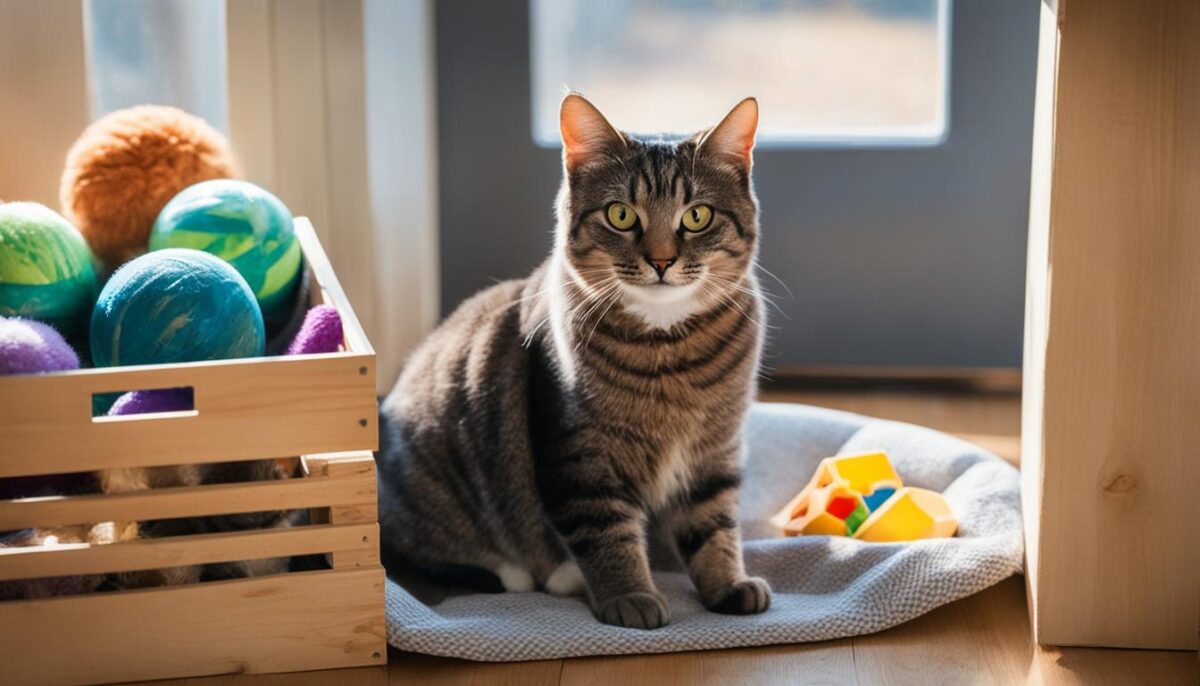Hey there! Do you want a happy home with your cute cats? Training your cats is a great way to make this happen. Don’t worry, it’s fun for you and your kitty! You can help cats learn good habits. This makes them even better friends. You can teach your cats to listen and to do cool tricks. Training also stops them from doing things we don’t like, like scratching the couch.
When you train your cats, you and your cats get to understand each other more. Always remember to use kind words and their favorite treats to help them learn. Training is not hard. Just take a little time each day to teach your cats new things. Soon, you’ll have a happy home with cats that know how to behave well.
Key Takeaways
- Training is good for cats and makes them happy.
- Cats can learn to listen and do tricks.
- Use treats and soft words to teach your cats.
- Teaching your cats makes you understand them better.
- Little lessons every day go a long way.
Understanding the Basics of Cat Training
Let’s talk about how teaching your cat can make both of you happy. It’s not just about doing fun tricks. It’s also about getting along and stopping those naughty habits.
Why Training Your Cat Is Beneficial
When you teach your cat, you’re helping to create a peaceful home. You learn to talk with your cat and help your little buddy stay out of trouble. A well-trained cat is often a happier cat too.
Positive Reinforcement: The Key to Success
To help your cat learn, always be kind. When your cat does something good, give them a little treat or a cuddle. This makes them want to do it again and stay healthy by keeping their brain and body busy.
Identifying Your Cat’s Motivational Treats
Finding out what treats make your cat’s eyes light up is super important. Every cat is different, so find that special snack or toy that gets them excited to learn. Here is what you should remember:
- Be patient: training takes time.
- Be consistent: always use the same words or actions to teach.
- Learn what your cat loves for the best results.
The Art of Cat Communication: Signals and Cues
When you talk to your kitty, it’s like using a secret language. This secret language helps you and your cat understand each other. This is super important when you are teaching your cat how to do cool things, like giving you a high-five or jumping through a hoop!
The Role of Consistent Cues in Training
Have you ever played Simon Says? It’s a game where you have to do what Simon tells you to do. Training your cat is kind of like playing Simon Says. You give your cat signals, or “cues,” and they follow them. But here’s the key: you have to use the same signals every time. This way, your cat won’t get mixed up and will know exactly what you’re asking.
Hand Signals Versus Voice Cues
There are two ways to give cues to your cat—using your hands or your voice. If you wave your hand a certain way, your cat can learn that this means to sit down. Or, if you say a word like “come” in a happy voice, your cat can learn to run over to you. Both ways are awesome, and it’s up to you to decide which one you and your cat like best.
https://www.youtube.com/watch?v=hW_GiC4xLD4
Understanding Your Cat’s Response
When you start using cues, watch how your cat reacts. Are they paying attention, or are they staring out the window? Maybe they need a little more practice, or perhaps they’re just not in the mood for training right now. Remember, your cat is not a robot; they have feelings too. So be patient and give them lots of love and yummy treats when they get it right. This will make training time fun and help you two become the best of friends!
Cat Training Techniques to Modify Behavior
Do you have a kitty who loves to scratch or jump on places they shouldn’t? Cat behavioral problems can be a challenge, but with the right tricks, you can help your cat be their best. Let’s talk about how to discourage bad habits and teach good ones. It’s all about friendly and gentle cat discipline.
Let’s say your cat scratches the couch. Ouch! A good trick is to get them a scratching post. This way, they can scratch without being naughty. Also, if your cat bites, give them a soft toy instead of your hand!
To stop a cat from jumping on counters, you can put something sticky, like double-sided tape, where they jump. Cats don’t like sticky paws, so they’ll think twice next time. And if your cat is doing something they shouldn’t, make a click sound. This will make them pause and look at you. Now you can show them what’s better to do.
Do you like walks? Your cat might too! Leash training lets you go on adventures together. Remember, always be kind and patient when teaching your cat. Include everyone at home in training, so your cat learns the rules are the same with everyone. Here are some simple steps to start:
- Get a nice scratching post for your cat.
- Use toys to help with biting.
- Place double-sided tape where you don’t want your cat to jump.
- Use click sounds to stop naughty actions.
- Practice walking on a leash for fun together.
Remember, cats are smart and can be great friends. With love and smart tricks, your furry friend will learn to be their best. Happy training!
Training Your Cat to Master Essential Skills
Hey there, cat pal! Let’s talk about litter training, crate familiarization, and some cool cat tricks. These skills are super helpful for both you and your furry friend. So, let’s get started and make learning fun!
Litter training your kitty is important. You want your cat to do their business in the right spot, right? Make sure their litter box is always clean and put it somewhere quiet. After mealtime, gently show your cat where the box is. They’ll catch on pretty quickly!
Next up is crate familiarization. This isn’t just about getting your cat into a crate. It’s about making the crate a comfy place for them. Leave the crate door open and let them explore. Over time, close the door for short bits. This way, trips to the vet won’t be so scary.
And now, let’s talk about some fun cat tricks! Teaching your kitty to “sit” or give a “high five” can be super fun. Talk about impressive! You can use a little clicker or their favorite treats to let them know they did a great job. Keep these practice times short and sweet, so they stay happy and ready to learn more.
Remember, it’s also cool to swap out those treats for a fun game or some loving praise. It’s all about keeping things happy for you and your cat. Now, check out this neat guide that’ll help you keep track of all these training steps:
| Skill | Training Steps | Tips for Success |
|---|---|---|
| Litter Box Training |
|
Be patient and keep the box clean |
| Crate Familiarization |
|
Make it comfy and never rush |
| Basic Cat Tricks |
|
Praise and play are great rewards |
Alright friend, you’re all set with the basics! Remember, take it one step at a time, and keep it fun. You and your kitty are going to be a great team. Let’s make those training moments shine!
Conclusion
By teaching your cat, you make a happy home for both of you. Learning together makes you and your cat closer. You will understand each other better and have fewer problems. It is fun to see your cat do new things and listen well. Remember, keep learning with your cat. It helps them stay happy and it keeps your home calm and nice.
Reaping the Benefits of a Well-Trained Cat
When your cat learns how to behave, good things happen. Your cat will listen to you and you two will get along great. No more worries about bad habits. You will feel proud of your kitty. So, keep showing your cat how to be good. And give them love and treats when they do well. This makes you both feel great!
Continuing Education for You and Your Feline
Teaching your cat never stops. Every day is a chance to learn more. This is called lifelong learning with cats. It means your kitty will always know how to be nice and friendly. You will always find new ways to help your cat learn. And the more you both learn, the more rewards you get. This is how you and your cat stay best friends forever.
FAQ
Is training really necessary for my cat, or is it just for entertainment?
Training is absolutely necessary, not just for entertainment. It’s crucial for behavior enhancement, establishing cat obedience, and maintaining a happy home with your feline friend. Training promotes mental stimulation, helps manage unwanted behaviors, and strengthens your bond with your cat.
How do I start training my cat and what should I focus on?
Begin by understanding the basics of cat training. Focus on cat behavior improvement via essential commands, and work towards fostering a healthy feline lifestyle. Start with simple commands and use positive reinforcement to encourage desired behaviors.
Why is positive reinforcement so important in cat training?
Positive reinforcement is the key to success for cat training because it encourages cats to repeat good behavior. This approach appeals to their natural instincts and promotes a healthy, engaging, and rewarding learning experience.
How can I find out which treats my cat likes best for training purposes?
Identifying your cat’s favorite treats involves a bit of trial and error. Offer various types of treats during training sessions and observe which ones your cat responds to most eagerly. Once identified, use these as motivational rewards during training.
What kind of cues should I use when training my cat?
The role of consistent cues is critical in cat training. Use either hand signals or voice cues for commands – consistency helps your cat understand and respond more reliably. Observe your cat’s preferences and adapt your cue method accordingly for the best response.
Are hand signals or voice cues more effective when training my cat?
Hand signals versus voice cues can both be effective, depending on your cat’s learning style. Some cats may respond better to visual signals, while others might prefer vocal commands. Consistency with whichever cues you choose is essential.
How can I tell if my cat is understanding and responding correctly to my cues?
Understanding your cat’s response to training cues is fundamental. Look for signs of recognition and positive responses, such as performing the requested action or showing interest. Regular practice will help improve your cat’s responsiveness.
What techniques can help modify my cat’s unwanted behaviors, like scratching or biting?
To discourage bad habits and address cat behavioral problems, provide appropriate alternatives, such as scratching posts for scratching or toys for biting. Use deterrents like double-sided tape to prevent counter-surfing, and apply consistent responses to unwanted behaviors. Engage your cat in positive activities like play as a form of cat discipline.
How do I litter train my cat?
Litter training involves placing a clean litter box in a quiet, accessible location. Guide your cat to the box after meals or when they show signs of needing to go. Most cats pick up on litter training quickly with a little guidance.
What basic commands should I teach my cat?
Start with simple commands like “sit” or “high five”, which can enhance feline behavior and discipline. Utilize clicker training or their favorite treats as rewards, and gradually replace treats with verbal praise or play over time to encourage these healthy behaviors.
How do I ensure my cat retains the training as it grows?
For lifelong learning with your cat, practice the skills regularly and reinforce good behaviors. Continuous education and patience are key to maintaining a peaceful coexistence and enjoying the cat training rewards over time.
Can I train my cat at any age?
Yes, you can train a cat at nearly any age, although starting as a kitten may be easier. Older cats can still learn, but may require more patience and a gradual approach to training.


